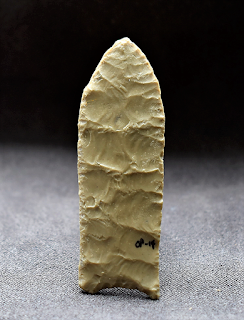For a long time, I have thought that this 2.45 inch long Paleoindian projectile point surface found in Cheyenne County, Colorado in figure one was
a Firstview dart point made by Cody Complex people ca. 9400 B.P.
Some of you might be asking 'what is a Firstview projectile point'? Here is a brief description and background.
In 1957, amateur archaeologist Jerry Chubbuck discovered a Paleoindian site while arrowhead hunting along a tributary of the Big Sandy Creek in Cheyenne County, Colorado. He brought the site to the attention of archaeologist Joe Ben Wheat from the University of Colorado Museum. Dr. Wheat did not have a chance to investigate the site until April 30, 1958. In the meantime, archaeologist H.M. Wormington suggested that Jerry Chubbuck and fellow arrowhead hunter Sig Olsen dig a few test pits near the exposed bonebed. Once Wheat freed up his schedule, Chubbuck and Olsen relinquished their digging permit to the University of Colorado Museum. A few of the projectile points surface found by Jerry Chubbuck are in figure two. Do you see the resemblance between these points and my Firstview projectile point in figures one, three, and four?
 |
| Figure Two - Gerry Chubbuck Firstview projectile points from the Olsen-Chubbuck bison kill site in Cheyenne County, Colorado. |
Chubbuck originally classified his points as Scottsbluff and Eden points from the Cody Complex. Quite honestly, I would classify his points as Scottsbluff and Eden projectile points even today! I am not sure the world needed the Firstview projectile point type.
As late as 1967, Joe Ben Wheat classified the projectile points from the Olsen-Chubbuck bison kill site as Scottsbluff, Eden, and Milnesand. By 1972, Wheat modified his original taxonomy for the projectile points and designated them as a new projectile point type called Firstview (Wheat 1972).
As late as 1967, Joe Ben Wheat classified the projectile points from the Olsen-Chubbuck bison kill site as Scottsbluff, Eden, and Milnesand. By 1972, Wheat modified his original taxonomy for the projectile points and designated them as a new projectile point type called Firstview (Wheat 1972).
Wheat described the dominant
style of points found at the Olsen-Chubbuck site as lanceolate or leaf-shaped, full-bodied
points. He stated that the stems on some of the Firstview projectile points were produced by
heavy edge grinding. He described the basal edge as predominately straight and mostly wedge-shaped. He defined the projectile point range from broad points with flattened lenticular
cross sections to relatively narrow points with diamond-shaped cross sections.
He noted that the points had extremely fine and excellent workmanship. I wonder why Wheat changed his mind from originally fitting these points into the existed projectile point typology of Scottsbluff, Eden, and Milnesand to defining a whole new point typology named Firstview?


My projectile point in figures
one, three, and four does have characteristics from the Firstview projectile point
type description, but is that the only projectile point type that it resembles?
Please, keep reading.
 |
| CLICK for SHADOWS on the TRAIL |
 |
| Figure Five - Cast of the Midland projectile point used as the type. |
Greg Perino (1985) describes Midland points as small, flat points that
resemble Folsom but with less basal indentation, and in some cases straight bases. Bruce Bradley (2010) expanded on the definition by stating that Midland points have
wide, but relatively flat flake scars and very flat cross sections. He stated
that flaking may be pressure, but for the most part Midland points appear to
have finely controlled percussion flaking. He stated that Midland knappers finished their points with non-invasive, abrupt continuous marginal retouch which narrowed the
pieces so that negative bulbs and thinning flakes were eliminated.
Figure Six shows my Firstview projectile point (middle point) in a line up with a few of my Midland projectile points. Do you see similarities between the Firstview and the Midland points? How about differences?
Figure Six shows my Firstview projectile point (middle point) in a line up with a few of my Midland projectile points. Do you see similarities between the Firstview and the Midland points? How about differences?
 |
| Figure Six - 2.45 inch long Firstview projectile point in center, surrounded by High Plains Midland projectile points. John Bradford Branney Collection. |
Now the big question. Is my projectile point a Firstview or a Midland or something else altogether? It makes no difference to me whether it is a Firstview or a Midland. Both are desirable projectile points. Midland projectile points are a thousand or so years older than Firstview projectile points. I am going to leave it up to you. What type is my projectile point?
Bradley, Bruce A
2010 Paleoindian Flaked Stone Technology on the Plains and in the Rockies in Prehistoric Hunter- Gatherers of the High Plains and Rockies by Marcel Kornfeld, George C. Frison and Mary Lou Larson.
Perino, Gregory
1985 Selected Preforms, Points, and Knives of the North American Indians - Volume 1.
Wheat, Joe Ben2010 Paleoindian Flaked Stone Technology on the Plains and in the Rockies in Prehistoric Hunter- Gatherers of the High Plains and Rockies by Marcel Kornfeld, George C. Frison and Mary Lou Larson.
Perino, Gregory
1985 Selected Preforms, Points, and Knives of the North American Indians - Volume 1.
1972 The Olsen-Chubbuck Site in American Antiquity, Volume 37, Number 1, Part 2.
 |
| SOON to be RELEASED in SEPTEMBER 2020 |
